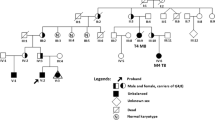Summary
Sperm chromosome complements have been studied in a man heterozygous for a reciprocal translocation t(2;5)(p11;q15). Human sperm chromosomes were obtained after fertilization of zona-free hamster eggs. A total of 75 human sperm metaphases were analysed. Of the complements studied, 59 (78.6%) resulted from a 2:2 segregation and 16 (21.3%) from a 3:1 segregation, 4:0 segregation was not observed. Our results indicate that at least 36% of sperm complements were unbalanced with respect to the translocation. The frequency of other chromosome anomalies unrelated to the translocation was 16%.
Similar content being viewed by others
References
Balkan W, Martin RH (1983) Chromosome segregation into the spermatozoa of two men heterozygous for different reciprocal translocations. Hum Genet 63:345–348
Benet J, Genescá A, Navarro J, Egozcue J, Templado C (1986a) G-banding of human sperm chromosomes. Hum Genet 73:181–182
Benet J, Fuster C, Genescá A, Navarro J, Templado C, Egozcue J (1986b) Expression of fragile sites in sperm chromosomes and lymphocyte chromosomes. 7th International Congress of Human Genetics, Berlin, 1986, p 213 (abstr)
Brandriff B, Gordon L, Watchmaker G (1985) Human sperm chromosomes obtained from hamster eggs after sperm capacitation in Test-Yolk buffer. Gamete Res 11:253–259
Brandriff B, Gordon L, Ashworth LK, Littman V, Watchmaker G, Carrano AV (1986) Cytogenetics of human sperm: meiotic segregation in two translocation carriers. Am J Hum Genet 38:197–208
Burns JP, Koduru PRK, Alonso ML, Chaganti RSK (1986) Analysis of meiotic segregation in a man heterozygous for two reciprocal translocations using the hamster in vitro penetration system. Am J Hum Genet 38:954–964
Chandley AC, Seuanez H, Fletcher JM (1976) Meiotic behaviour of five reciprocal translocations. Cytogenet Cell Genet 17:98–111
Chandley AC, Speed RM, McBeath S, Hargreava TB (1986) A human 9;20 reciprocal translocation associated with male infertility analyzed at prophase and metaphase I of meiosis. Cytogenet Cell Genet 41:145–153
Egozcue J, Marina S, Templado C (1981) Meiotic behaviour of two human reciprocal translocations. J Med Genet 18:362–365
Jalbert P, Sele B (1979) Factors predisposing to adjacent-2 and 3:1 disjunctions: study of 161 human reciprocal translocations. J Med Genet 16:467–478
Jalbert P, Sele B, Jalbert H (1980) Reciprocal translocations: a way to predict the mode of unbalanced segregation by pachytene-diagram drawing. Hum Genet 55:209–222
Laurie DA, Palmer RW, Hultén MA (1984) Studies on chiasma frequency and distribution in two fertile men carrying reciprocal translocations: one with a t(9;10) karyotype and one with a t(Y;10) karyotype. Hum Genet 68:235–247
Lejeune J (1963) Autosomal disorders. Pediatrics 8:326–337
Lindenbaum RH, Bobrow M (1975) Reciprocal translocations in man. 3:1 meiotic disjunction resulting in 47 or 45 chromosome offspring. J Med Genet 12:29–43
Martin RH (1983) A detailed method for obtaining preparations of human sperm chromosomes. Cytogenet Cell Genet 35:252–256
Martin RH (1984) Analysis of human sperm chromosomes from a male heterozygous for a reciprocal translocation t(11;22)(q23;q11). Clin Genet 25:357–361
Oikawa K, Trent M, Lebovitz R (1977) Familial balanced translocation 4p+/17p- as a suggested cause of primary trisomy-21 Down's syndrome. Arch Dis Child 52:890–893
Saadallah N, Hultén MA (1985) A complex three-breakpoint translocation involving chromosomes 2,4, and 9 identified by meiotic investigations of a human male ascertained for subfertility. Hum Genet 71:312–320
Author information
Authors and Affiliations
Rights and permissions
About this article
Cite this article
Templado, C., Navarro, J., Benet, J. et al. Human sperm chromosome studies in a reciprocal translocation t(2;5). Hum Genet 79, 24–28 (1988). https://doi.org/10.1007/BF00291704
Received:
Revised:
Issue Date:
DOI: https://doi.org/10.1007/BF00291704




